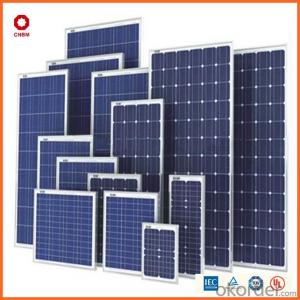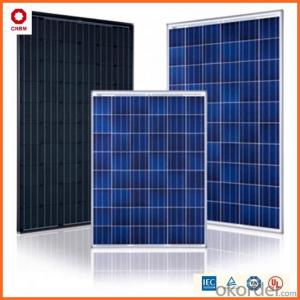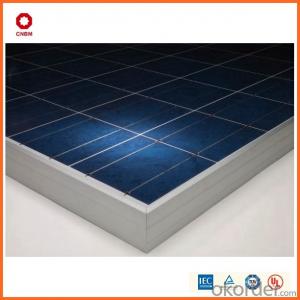Small Solar Panel 55w Poly with Good Quality
- Loading Port:
- China main port
- Payment Terms:
- TT OR LC
- Min Order Qty:
- 1 watt
- Supply Capability:
- 10000000 watt/month
OKorder Service Pledge
OKorder Financial Service
You Might Also Like
Item specifice
Product Description:
Hot Sale !!! Quality and Safety of Small Poly Solar Panel 35~85w
1. Rigorous quality control meets the highest international standards.
2. High-transmissivity low-iron tempered glass, strong aluminium frame.
3. Using UV-resistant silicon.
4. IS09001/14001/CE/TUV/UL
Warranties of Small Poly Solar Panel 35~85w
1. 10 years limited product warranty
2. 15 years at 90% of the minimal rated power output
3. 25 years at 80% of the minimal rated power output
Specification
Characteristics of Poly solar panels CNBM (245-320W) | |||||
Max Power Voltage Vmp(V) | 30.3 | 30.8 | 31.1 | 31.4 | 31.85 |
Max Power Current Imp(A) | 7.60 | 7.64 | 7.73 | 7.81 | 7.85 |
Open Circuit Voltage Voc(V) | 36.1 | 36.6 | 37 | 37.3 | 37.68 |
Short Circuit Current Isc(A) | 8.50 | 8.55 | 8.65 | 8.75 | 8.85 |
Max Power Pm(W) | 230W | 235W | 240W | 245W | 250W |
Temperature Coefficient of Cells Poly solar panels CNBM (245-320W) | |
NOCT | 45± 2 |
Temperature Coeffucients of Isc | 0.0492 |
Temperature Coeffucients of Voc | -0.3374 |
Temperature Coeffucients of Voc | -0.4677 |
Mechanical Data of Poly solar panels CNBM (245-320W) | |
Dimension | 1638 × 982 × 40 mm |
Weight | 19.5 kg |
No. of Cells and Connections | 60 (6 ×10) |
Tolerance | 0 ~ + 5 W |
Cell | Monocrystalline Cell 156 × 156 mm |
Packing | 624 Pcs/40ft(H) Container |
Limits of Poly solar panels CNBM (245-320W) | |
Operating Temperature | -40 to +85 |
Storage Temperature | -40 to +85 |
Max System Voltage | 1000VDC(IEC) / 600VDC(UL) |
Features of our products:
• High conversion efficiency mono/poly-crystalline amorphous silicon solar cells
• Modules incorporate high performance bypass diodes to minimize the power drop caused by shading
• High transmittance, low-iron tempered glass
• High performance EVA encapsulant to prevent destroying and water.
• AI frame: without screw, corner connection. 8 holes on the frame can be installed easily
• Good performance of preventing from atrocious weather such as wind and hails
• Certifications: CE IEC TUV VDE UL, Class I
• 10 years 90% power output warranty

Shipping of Small Poly Solar Panel 35~85w
By Sea | Delivery from Shanghai or Ningbo seaport |
By Air | Departure from Shanghai Pudong Airport |
By Express | Post by DHL, EMS, UPS, TNT. |
- Q:Are there any disadvantages of solar energy systems?
- Although solar energy systems offer numerous advantages, they also have a few drawbacks. One major disadvantage is the high initial installation cost, which can be unaffordable for certain individuals or businesses due to the substantial expenses associated with purchasing and setting up solar panels. Moreover, external factors such as weather conditions, shading, and panel angles can affect the efficiency of solar panels, limiting their effectiveness in specific locations. Another drawback is the intermittent nature of solar power, as it can only be generated during daylight hours and is unavailable during cloudy or nighttime conditions. This necessitates the installation of costly battery systems for energy storage or reliance on the grid during non-generating periods. Lastly, the production of solar panels requires the use of certain materials, some of which are non-renewable and can have negative environmental impacts during the extraction and manufacturing processes. Nonetheless, advancements in technology and decreasing costs are continually enhancing the efficiency and affordability of solar energy systems.
- Q:What is the role of solar cookers in solar energy systems?
- The role of solar cookers in solar energy systems is to harness the power of the sun to cook food. They use reflective surfaces to concentrate sunlight onto a cooking vessel, converting solar energy into heat. Solar cookers are an environmentally friendly alternative to traditional cooking methods that rely on fossil fuels, as they reduce greenhouse gas emissions and promote sustainable energy use. They are particularly beneficial in areas with limited access to electricity or clean cooking fuel, improving health and reducing deforestation.
- Q:Can solar energy systems be integrated into existing electrical systems?
- Yes, solar energy systems can be integrated into existing electrical systems. By installing solar panels on rooftops or other suitable locations, the generated electricity can be fed into the existing electrical system, reducing the reliance on traditional sources of electricity and potentially lowering energy costs. However, it is important to ensure the compatibility and capacity of the existing electrical infrastructure to handle the additional power supply from the solar energy system.
- Q:How does net metering work?
- Net metering is a billing arrangement that allows customers with solar panels or other renewable energy systems to receive credit for any excess electricity they generate and feed back into the grid. The electricity meter measures the difference between the energy consumed from the grid and the energy generated by the customer's system. This net difference determines the amount of energy credited or charged to the customer's account. In essence, net metering enables homeowners to offset their electricity costs and promotes the adoption of clean energy sources.
- Q:Can solar energy systems be used for powering electric train systems?
- Electric train systems can be powered using solar energy systems. Photovoltaic (PV) panels or concentrated solar power (CSP) systems can convert solar energy into electricity, eliminating the need for fossil fuel engines. The feasibility of solar energy for trains depends on factors like sunlight availability, panel size and efficiency, and energy requirements. For example, regions with abundant sunlight, like deserts, can effectively harness solar energy for trains. Solar-powered train systems already exist globally. The Byron Bay Train in Australia relies solely on a solar train system with panels and battery storage. In India, a railway line section is powered by solar energy, providing sustainable transportation. Implementing solar energy systems for electric trains brings numerous benefits. It reduces dependence on fossil fuels, lowering greenhouse gas emissions and combating climate change. Solar energy is renewable, offering a sustainable long-term solution. Additionally, solar-powered trains have lower operating costs due to reduced maintenance and stable fuel prices. However, challenges exist with solar energy for train systems. Initial installation costs can be high, but long-term savings outweigh the investment. Sunlight intermittency is also a challenge, especially during cloudy or nighttime conditions. This can be resolved using battery storage systems that store excess energy for later use. In conclusion, solar energy systems are viable for powering electric train systems. Advancements in solar technology and the need for sustainable transportation position solar-powered trains as a significant factor in the future of rail transportation, promoting clean energy and reducing environmental impact.
- Q:Can solar energy systems be used for powering streetlights or outdoor lighting?
- Yes, solar energy systems can definitely be used for powering streetlights or outdoor lighting. Solar-powered streetlights and outdoor lighting systems are becoming increasingly popular as they offer a sustainable and cost-effective solution. These systems harness energy from the sun during the day, store it in batteries, and then use it to power the lights at night. This reduces dependence on traditional electricity sources and helps in reducing carbon emissions, making it an environmentally friendly option for outdoor lighting.
- Q:What is the impact of hail on solar panels?
- Hail can have a detrimental impact on solar panels, as the forceful impact of hailstones can cause physical damage to the panels. This damage can result in cracks or fractures in the glass or photovoltaic cells, reducing the efficiency and effectiveness of the panels. Furthermore, hail can also impair the electrical connections within the solar panel system, leading to malfunction or complete failure. Therefore, it is important to consider protective measures, such as installing hail guards or utilizing insurance policies, to mitigate the potential damage caused by hail on solar panels.
- Q:Is it possible to store excess solar energy for later use?
- Yes, it is possible to store excess solar energy for later use.
- Q:Can solar energy systems be used in powering recreational facilities like gyms or spas?
- Yes, solar energy systems can definitely be used to power recreational facilities like gyms or spas. Solar panels can be installed on the roofs or grounds of these facilities to convert sunlight into electricity. This renewable energy source can provide a significant portion, if not all, of the power needed to operate the facilities. Additionally, solar energy systems can help reduce the carbon footprint of these establishments and contribute to a more sustainable and environmentally friendly operation.
- Q:How does the orientation of solar panels affect their performance?
- The orientation of solar panels plays a crucial role in determining their performance and efficiency in harnessing solar energy. The ideal orientation of solar panels is to face directly towards the sun, maximizing the amount of sunlight they receive throughout the day. In most cases, solar panels are installed on rooftops or mounted on frames, allowing them to be adjusted to the desired angle. The optimal orientation depends on the geographical location of the solar panels, as well as the season and time of day. When solar panels are angled towards the sun, they are able to capture the maximum amount of sunlight, maximizing their efficiency. If solar panels are not properly oriented, they will receive less sunlight and produce less electricity. In the northern hemisphere, solar panels are typically installed facing south to capture the most sunlight throughout the day. Conversely, in the southern hemisphere, solar panels are oriented towards the north. This south or north orientation allows the panels to receive sunlight for the longest duration during the day. The tilt angle of solar panels also affects their performance. The ideal tilt angle is typically equal to the latitude of the location where the solar panels are installed. However, this angle can be adjusted to optimize energy production during different seasons. For instance, in winter, the panels can be tilted at a steeper angle to capture more sunlight, while in summer, a shallower tilt angle can prevent overheating. If solar panels are improperly oriented, their performance can be significantly reduced. In such cases, they may not generate the expected amount of electricity, resulting in lower energy output. Therefore, it is crucial to consider the orientation and tilt angle when installing solar panels to ensure maximum efficiency and optimal energy production.
1. Manufacturer Overview |
|
|---|---|
| Location | |
| Year Established | |
| Annual Output Value | |
| Main Markets | |
| Company Certifications | |
2. Manufacturer Certificates |
|
|---|---|
| a) Certification Name | |
| Range | |
| Reference | |
| Validity Period | |
3. Manufacturer Capability |
|
|---|---|
| a)Trade Capacity | |
| Nearest Port | |
| Export Percentage | |
| No.of Employees in Trade Department | |
| Language Spoken: | |
| b)Factory Information | |
| Factory Size: | |
| No. of Production Lines | |
| Contract Manufacturing | |
| Product Price Range | |
Send your message to us
Small Solar Panel 55w Poly with Good Quality
- Loading Port:
- China main port
- Payment Terms:
- TT OR LC
- Min Order Qty:
- 1 watt
- Supply Capability:
- 10000000 watt/month
OKorder Service Pledge
OKorder Financial Service
Similar products
New products
Hot products
Related keywords






























